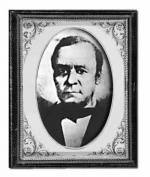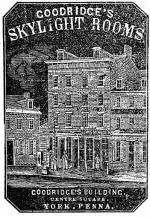![header=[Marker Text] body=[Here lived an ex-slave, born 1805, who became a prominent York businessman, 1824-1863. Tanner, newspaper distributor, barber. Erected York's first five-story building. His 13 rail cars operated commercially and were used in his work for the Underground Railroad. ] sign](http://explorepahistory.com/kora/files/1/10/1-A-10E-139-ExplorePAHistory-a0a4i1-a_450.gif)
Mouse over for marker text
Name:
William C. Goodridge
Region:
Hershey/Gettysburg/Dutch Country Region
County:
York
Marker Location:
123 E. Philadelphia St. (PA 74 and 462 westbound), York
Dedication Date:
December 17, 1987
Behind the Marker
Born a slave in Baltimore, Maryland, in 1806, William C. Goodridge was just five or six years old when he was indentured to Reverend Michael Dunn, who operated a tannery in York, Pennsylvania. Goodridge received his freedom in 1822 when Dunn went bankrupt, then moved to Marietta, Pennsylvania, where he learned the trade of a barber. After returning to York in 1824 opened his own barber shop and soon diversified, selling candy, cosmetics, jewelry, and toys. There, too, he manufactured “Oil of Celsus,” his own treatment for baldness, which he marketed to barbers in more than a dozen cities, including Philadelphia.
Goodridge then opened an employment agency, began to invest in commercial and residential real estate, and in 1842 opened his own freight service, the “Reliance Line of Burthen Cars” on the railroad line between York and Philadelphia. Cementing his position in York, he in 1847 built Centre Hall, a five-story commercial property in the center of town.
the railroad line between York and Philadelphia. Cementing his position in York, he in 1847 built Centre Hall, a five-story commercial property in the center of town.
By the mid-1840s Goodridge had joined William Whipper and
William Whipper and  Stephen Smith in nearby Columbia as the wealthiest African American businessmen in south central Pennsylvania. A civic leader in York’s small African American community with a broad network of personal and business contacts that extended from Maryland to Canada, Goodridge also became active in the Underground Railroad. As a mixed race businessman in a town and state where many vehemently opposed the abolition movement, Goodridge kept a low profile, especially after passage of the Fugitive Slave Act in 1850 made aiding escaped slaves a federal crime, so we will never know the extent of his activities. His name, however, is associated with two major events in the struggle against slavery.
Stephen Smith in nearby Columbia as the wealthiest African American businessmen in south central Pennsylvania. A civic leader in York’s small African American community with a broad network of personal and business contacts that extended from Maryland to Canada, Goodridge also became active in the Underground Railroad. As a mixed race businessman in a town and state where many vehemently opposed the abolition movement, Goodridge kept a low profile, especially after passage of the Fugitive Slave Act in 1850 made aiding escaped slaves a federal crime, so we will never know the extent of his activities. His name, however, is associated with two major events in the struggle against slavery.
In the aftermath of the Christiana riot in neighboring Lancaster County, some of the black men who had participating in that deadly firefight made the first leg of their trip north to safety in Canada concealed in a special freight car of Goodridge’s Reliance Line. In the aftermath of John Brown’s failed raid on the federal arsenal in Harpers Ferry in October 1859, Osborne Perry Anderson, one of Brown’s trusted lieutenants, fled to York, where Goodridge arranged his safe passage by railroad to Philadelphia.
Christiana riot in neighboring Lancaster County, some of the black men who had participating in that deadly firefight made the first leg of their trip north to safety in Canada concealed in a special freight car of Goodridge’s Reliance Line. In the aftermath of John Brown’s failed raid on the federal arsenal in Harpers Ferry in October 1859, Osborne Perry Anderson, one of Brown’s trusted lieutenants, fled to York, where Goodridge arranged his safe passage by railroad to Philadelphia.
In 1858 Goodridge went bankrupt and was forced to sell twenty properties, including the family home on Philadelphia Street. Going back to barbering he remained in York during the Civil War, then moved to East Saginaw, Michigan, in 1865 to live with his daughter and sons. There Goodridge died in 1873.
bankrupt and was forced to sell twenty properties, including the family home on Philadelphia Street. Going back to barbering he remained in York during the Civil War, then moved to East Saginaw, Michigan, in 1865 to live with his daughter and sons. There Goodridge died in 1873.
In 1998, the Goodridge home in York became one of the first Underground Railroad sites designated by the National Park Service as a National Historic Landmark. There the Goodridge Freedom House and Underground Railroad Museum is working towards opening a museum in his honor.
Goodridge then opened an employment agency, began to invest in commercial and residential real estate, and in 1842 opened his own freight service, the “Reliance Line of Burthen Cars” on
By the mid-1840s Goodridge had joined
In the aftermath of the
In 1858 Goodridge went
In 1998, the Goodridge home in York became one of the first Underground Railroad sites designated by the National Park Service as a National Historic Landmark. There the Goodridge Freedom House and Underground Railroad Museum is working towards opening a museum in his honor.
Beyond the Marker









